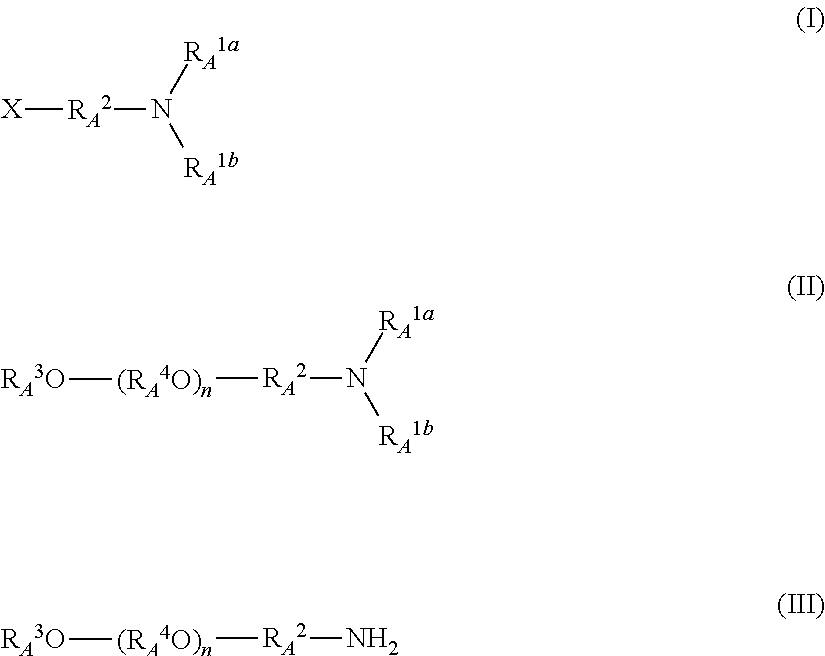Method for producing polyalkylene glycol derivative having amino group at end
- Summary
- Abstract
- Description
- Claims
- Application Information
AI Technical Summary
Benefits of technology
Problems solved by technology
Method used
Image
Examples
synthesis example 1
Synthesis of Polymerization Initiator (Va)
[0162]After placement of a stirring bar in a 500 mL two neck round-bottom flask, a rectification tube, a thermometer, a Liebig condenser, a fractionating column, two 50 mL round-bottom flasks, and one 300 mL two neck flask were connected, so that a distillation device was assembled. After the degree of vacuum in the device was held at 10 Pa or less, the internal part of the device was heated with an oil bath and a heat gun, so that the water content in the system was removed. Subsequently diethylene glycol monomethyl ether (made by Tokyo Chemical Industry Co., Ltd.) was injected into the 500 mL two neck round-bottom flask under nitrogen stream, and reduced-pressure distillation was performed. The measured water content ratio was 1 ppm or less after distillation (Measurement of the water content ratio was performed by a Karl Fisher moisture meter, and the same applies hereinafter).
[0163]After placement of a stirring bar in a 3 L two neck roun...
synthesis example 1-1
Synthesis of Polymerization Initiator (Va) by Another Method
[0165]Distillation of diethylene glycol monomethyl ether and THF was performed in the same manner as in the [Synthesis Example 1]
[0166]In a glove box under nitrogen atmosphere, 1.28 g of naphthalene and 0.43 g of potassium were weighed and fed into a 100 mL three neck flask, and vacuum drying was performed for 1 hour. The flask was then brought back under a nitrogen atmosphere, and 13.58 g of distilled THF was added into the flask with a syringe. Stirring was performed for 1 hour to prepare a THF solution of potassium naphthalenide (0.65 mmol / g). On the other hand, 1.00 g of distilled diethylene glycol monomethyl ether was weighed with a syringe and fed into a 50 mL three neck flask under nitrogen atmosphere. 12.33 g of the THF solution of potassium naphthalenide prepared above was dripped thereto at normal temperature. Maturation was performed for 1 hour, so that 13.33 g (0.64 mmol / g) of a THF solution of the polymerizatio...
synthesis example 2
Synthesis of Electrophile (Ia)
[0167](2-1) Synthesis of silyl protector (I-1) In a 300 ml three neck flask, 6.0 g of 3-amino-1-propanol, 28.74 g of triethylamine, and 18.0 g of toluene were charged, and then 75.0 g of TESOTf was dripped therein under a nitrogen atmosphere. Stirring was then performed at 80° C. for 25 hours. The reaction liquid was transferred into a separatory funnel, the lower layer was separated, and the upper layer was distilled under reduced pressure, so that 31.47 g (yield rate 93.3%) of a silyl protector (I-1) was produced.
[0168]Silyl protector (I-1)
[0169]Colorless liquid
[0170]Boiling point 133 to 138° C. / 10 Pa
[0171]1H-NMR (500 MHz, CDCL3): δ=0.60 (18H, q), 0.94 (27H, t), 1.62 (2H, m), 2.83 (2H, m), and 3.54 (2H, t)
[0172]In the formula, TES means a triethylsilyl group.
[0173](2-2) Synthesis of alcohol having silyl-protected amino group (I-2) In a 200 ml one neck flask, 30.98 g of silyl protector (I-1), 30.98 g of methanol, and 0.2 g of sodium methoxide were char...
PUM
| Property | Measurement | Unit |
|---|---|---|
| Temperature | aaaaa | aaaaa |
| Fraction | aaaaa | aaaaa |
| Fraction | aaaaa | aaaaa |
Abstract
Description
Claims
Application Information
 Login to View More
Login to View More - R&D
- Intellectual Property
- Life Sciences
- Materials
- Tech Scout
- Unparalleled Data Quality
- Higher Quality Content
- 60% Fewer Hallucinations
Browse by: Latest US Patents, China's latest patents, Technical Efficacy Thesaurus, Application Domain, Technology Topic, Popular Technical Reports.
© 2025 PatSnap. All rights reserved.Legal|Privacy policy|Modern Slavery Act Transparency Statement|Sitemap|About US| Contact US: help@patsnap.com



